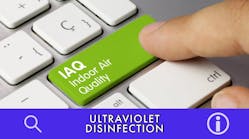Industry expert launches All Things Lighting Association (UPDATED)
The All Things Lighting Association (ATLA) was recently announced by founder Ian Ashdown, P. Eng. (Ret.), FIES — a longtime member of several established industry associations, lighting scientist, and president of software development firm SunTracker Technologies. ATLA’s mission, according to its inaugural release, is “to advance, support, promote, and contribute to innovation, science, and engineering in all fields of lighting, including architecture, health, horticulture, and entertainment.”
LEDs Magazine reached out to Ashdown (who has served as Strategies in Light advisory board member, LEDs Magazine Sapphire Awards judge, and editorial contributor) for elaboration on the launch and the role of ATLA in the academic and design community.
Ashdown explained that in conjunction with international contributors, ATLA has developed two standards for the international lighting community. “The first reason [for launching a new association] is to provide ATLA S001, Standard Format for the Electronic Transfer of Luminaire Optical Data, and ATLA S001-A, Amendment to Standard Format for the Electronic Transfer of Luminaire Optical Data, Including JSON Specification, as freely-available standards for lighting industry adoption,” said Ashdown via email. “ATLA S001 has been adopted as ANSI/IES TM-33-18 and (in Italian) UNI 11733:2019, while ATLA S001-A is currently under consideration by CIE Technical Committee 2-92.* If approved, ATLA S001-A will likely become a joint CIE/ISO standard. It is also under consideration by the IES as a successor to TM-33-18.”
According to the current ATLA S001 documentation, existing standards for electronic transmission of far-field photometric data and other information do not account for spectral power distribution (SPD) or radiant intensity distributions and photosynthetically active radiation (PAR) used in horticultural or animal-centric applications such as aquaculture and animal husbandry. ATLA 2001 is intended to provide a standardized format for all types of luminaire optical test data that can be conveyed in an XML Schema so the data can then be analyzed across multiple types of design, visualization, and simulation software tools used by lighting and architecture professionals. ATLA-S001A amends the 2018 ATLA 2001 to include JSON format guidance that can reduce the complexity of XML documentation.
When asked about affiliations, Ashdown indicated that “at present, ATLA has no formal relationship with ANSI, ASABE, CIE, IES, ISO or other standards organizations.” As a secondary objective, he expects ATLA to continue growing a knowledge base of lighting issues and projects; provide an opportunity for graduate student mentorship and funding; and facilitate academic and industry collaboration.
“The goal of ATLA is to encourage and support its members in thinking of lighting research and design not as ‘illumination engineering,’ but as a cross-disciplinary topic rich in opportunities for both researchers and companies,” said Ashdown.
Cross-disciplinary research and commercial development have supplied the backbone of multiple academic centers and laboratories involved in advancing solid-state lighting (SSL) and lighting design best practices.
For example, the New York State Energy Research and Development Authority (NYSERDA) established the Lighting Research Center (LRC) at Rensselaer Polytechnic Institute (RPI), which has since split into separate organizations supported by RPI and the Mount Sinai healthcare organization. LRC had expanded its studies of lighting applications and technology into a continuing education program, collaboration on standards development, and work with commercial partners on 3-D printing for LED lighting.
RPI’s Lighting Enabled Systems and Applications (LESA) Center laboratory and Center for Architecture Science and Ecology (CASE) leadership has also partnered to incubate technologies that will enable net-zero buildings and climate resilience through architectural design and applied engineering in its Institute for Energy, the Built Environment, and Smart Systems (EBESS).
Both examples are aligned with a specific academic institution, of course. Ashdown’s hope for ATLA is to encourage open participation and contributions “from the community at large” within the scope of an online platform.
Readers can access the documentation for ATLA 2001 and 2001-A and learn more on ATLA’s website.
CARRIE MEADOWS is managing editor of LEDs Magazine, with 20 years’ experience in business-to-business publishing across technology markets including solid-state technology manufacturing, fiberoptic communications, machine vision, lasers and photonics, and LEDs and lighting.
*Updated Feb. 11, 2022 for clarification of ATLA 2001-A status in CIE Technical Committee 2-92, by request of All Things Lighting Association.
For up-to-the-minute LED and SSL updates, why not follow us on Twitter? You’ll find curated content and commentary, as well as information on industry events, webcasts, and surveys on our LinkedIn Company Page and Facebook page.

Carrie Meadows | Editor-in-Chief, LEDs Magazine
Carrie Meadows has more than 20 years of experience in the publishing and media industry. She worked with the PennWell Technology Group for more than 17 years, having been part of the editorial staff at Solid State Technology, Microlithography World, Lightwave, Portable Design, CleanRooms, Laser Focus World, and Vision Systems Design before the group was acquired by current parent company Endeavor Business Media.
Meadows has received finalist recognition for LEDs Magazine in the FOLIO Eddie Awards, and has volunteered as a judge on several B2B editorial awards committees. She received a BA in English literature from Saint Anselm College, and earned thesis honors in the college's Geisel Library. Without the patience to sit down and write a book of her own, she has gladly undertaken the role of editor for the writings of friends and family.
Meadows enjoys living in the beautiful but sometimes unpredictable four seasons of the New England region, volunteering with an animal shelter, reading (of course), and walking with friends and extended "dog family" in her spare time.




![The DesignLights Consortium continues to make progress in shifting outdoor lighting products and implementation practices toward a more restrained and thoughtful strategy. [Image does not represent a DLC qualified fixture.] The DesignLights Consortium continues to make progress in shifting outdoor lighting products and implementation practices toward a more restrained and thoughtful strategy. [Image does not represent a DLC qualified fixture.]](https://img.ledsmagazine.com/files/base/ebm/leds/image/2024/08/66be810888ae93f656446f61-dreamstime_m_265700653.png?auto=format,compress&fit=&q=45&h=139&height=139&w=250&width=250)
